O OVGA é um Centro de Ciência que desenvolve atividade de investigação aplicada e de divulgação científica na área da Vulcanologia, da Sismologia e da Geotermia.
Notícia -A A +A
Forecasting Volcanic Eruptions with Artificial Intelligence - Notícia OVGA 04-12-2019

Ash from Sierra Negra, a volcano on Isla Isabela in the Galápagos Islands, drifts across the sky during an October 2005 eruption. Researchers used satellite data leading up to a 2018 eruption at Sierra Negra to test an algorithm designed to detect signals that indicate potential volcanic unrest.
Credit: NASA image created by Jesse Allen, Earth Observatory, using data obtained courtesy of the MODIS Rapid Response Team
Most of the roughly 1,400 active volcanoes around the world, including many in the United States, do not have on-site observatories. Lacking ground-level data, scientists are turning to satellites to keep tabs on volcanoes from space. Now using artificial intelligence, scientists have created a new satellite-based method of detecting warning signs of when a volcano is likely to erupt.
Gaddes et al. took advantage of satellites that carry instruments equipped to collect imagery using interferometric synthetic aperture radar (InSAR), which can detect centimeter-scale deformations of Earth’s surface. Every time one of the satellites passes over a given volcano—typically once every 12 days—it can capture an InSAR image of the volcano from which ground movement away from or toward the satellite can be calculated.
InSAR can often pick up the ominous expansion of the ground that occurs when magma moves within a volcano’s plumbing, but it is difficult to continuously monitor the huge number of images produced by the latest generation of SAR-equipped satellites. In addition, some volcanoes exhibit long-lasting deformation that poses no immediate threat, and new images must be compared with older ones to determine whether a deformation at a volcano is a warning sign or just business as usual.
To solve these issues, the researchers turned to machine learning, a form of artificial intelligence that can glean subtle patterns in vast quantities of data. They developed an algorithm that can rapidly analyze InSAR data, compare current deformation to past activity, and automatically create an alert when a volcano’s unrest may be cause for concern.
To test the algorithm’s viability, the team applied it to real data from the period leading up to the 2018 eruption of Sierra Negra, a volcano in the Galápagos Islands. The algorithm worked, flagging an increase in the ground’s inflation that began about a year before the eruption. Had the method been available at the time, the team writes, it would have accurately alerted researchers that Sierra Negra was likely to erupt.
Fonte: eos.org (03-12-2019)
